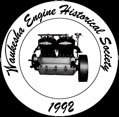Waukesha Model Designations (added January 2013)(amended February 2013)
Waukesha Engine Model Designations
1906-1963
From 1906 to 1963 Waukesha used three different engine model designation schemes. (Note: I did not include the model designations for the Waukesha co-operative fuel research engines.)
1. Engine models designated by letters of the alphabet
The very first engine models were all4 cylinder engines and were simply identified by a letter of the alphabet, usually assigned in alphabetical ordered, but not always. The first Waukesha engine was identified as the Model A. Eventually every letter in the alphabet would be used as a model designation up to and included the Model Z for the 4-cylinder engines.
Six-cylinder engines were introduced in 1924 and they also used letters of the alphabet for model designation, but were prefixed with the numeral "6". The first 6-cylinder engine was designated as the Model 6A.
2. Engine models designated with the prefix numbers "4" and "6"
For a short period of time in the 1930's, Waukesha produced "F-Head" engines that had the exhaust valve in the engine block and intake valve in the cylinder head. These models had a prefix "4" for 4-cylinder engines, and a pre-fix "6" for 6-cylinder engines. These numerals designated the number of cylinders in the engine and were followed by a dash number that designated the approximate maximum HP of the engine. Examples of these "F-Head" engine models were;
Model 4-80, a 4-cylinder engine producing approximately 80 HP
Model 6-100, a 6-cylinder engine producing approximately 100 HP
Model 6D-125, a 6-cylinder diesel engine producing approximately 125 HP
3. Engine Models designated by 3 numerals
After all the letters in the alphabet had been used up for the 4-cylinder models, a new model designation for new engines was introduced. It consisted of using the first 3-digits of the 6-digit part number series assigned to identify the main components of a new engine model. For example; the new engine model that was assigned the 130,000 series of part numbers for its main engine components was designated as the Model130. Engine models using this scheme included the Models 130, 135, 137, 140, 145, 148, 150, 151, 160, 165, 170, 175, 180, 185, 190, 195, 197
In each of the three model designation schemes, suffix letter were added to the basic engine model designation to identify engine variations.
Meaning of suffix letters
A = automotive; or redesigned
B = counterbalanced crankshaft; or Lanova combustion chamber; or Military engine
C = Comet combustion chamber; or Military; or high output; or major revision
D = diesel engine; or draw-thru carburetion
E = exhaust gas recirculation
F = full pressure lubrication; or Fire Underwriters unit
G = carbureted engine (gasoline and gaseous fuel)
H = overhead valves; or Hesselman engine
I = intercooled ---(actually aftercooled)
J = Fuller-Johnson--- as in engine Model FJ
K = larger bore; or kerosene fueled engines introduced after WWII
L = large bore, as in Model JL; later used for standard bore size; also for liquid fuel (gas turbine engine); or Lean Bum
M = marine; or medium bore as in Model JM; or Military engine
N = natural gas fueled
0 = overhead valve as in Model 6LRO
P = propane fueled
Q = not used
R = cast iron crankcase (earliest engines had aluminum crankcases for weight reduction, but when the price of aluminum sky-rocketed the change was made to cast iron); or redesigned; or reverse exhaust, or diesel crankcase and crankshaft on a gas engine)
S = small bore as in Model JS; or supercharged and turbo-supercharged engines
T = turbocharged
U = power unit; or aluminum crankcase
V = vee engine; or vacuum controlled injection pump (Hesselman engines)
W = not used
X = mushroom tappets for Model BUX
Y = not used
Z = largest bore in a Model series of engines
In some instances an engine model designation would consist of several suffix letters. For example:
Model VLRDBSIM
VLR = basic model designation, being the V-12 version of the popular 6LR
D = diesel
B = counter -balanced crankshaft
S = turbocharged (exhaust gas driven supercharger)
I = intercooled (actually after-cooled)
M = marine configuration
Model 6SRKR
6 = 6 cylinder
S = basic model designation
R = cast iron crankcase
K = larger bore in the model series
R = redesigned
Model 195GKAUF
195 = basic model designation, being the first three digits of the 195,000 part numbers assigned for the engine's major components.
G = carbureted (in this case natural gas)
K = larger bore in model series
A = redesigned
U = power unit
F = Fire Underwriters approved
Rocky Schaefer 10-2011 revised 11-2012
Copyright © 2013 Waukesha Engine Historical Society, Inc. All rights reserved
